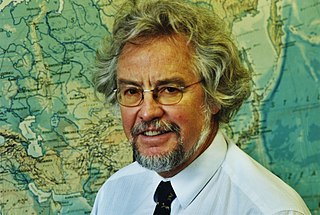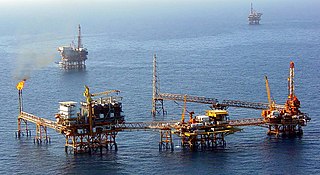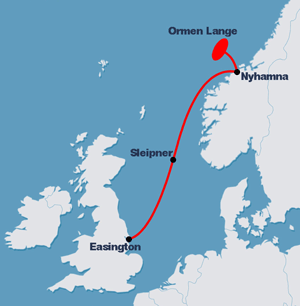Related Research Articles

Harold Eugene "Doc" Edgerton, also known as Papa Flash, was an American scientist and researcher, a professor of electrical engineering at the Massachusetts Institute of Technology. He is largely credited with transforming the stroboscope from an obscure laboratory instrument into a common device. He also was deeply involved with the development of sonar and deep-sea photography, and his equipment was used in collaboration with Jacques Cousteau in searches for shipwrecks and even the Loch Ness Monster.
In fluid dynamics, a Kármán vortex street is a repeating pattern of swirling vortices, caused by a process known as vortex shedding, which is responsible for the unsteady separation of flow of a fluid around blunt bodies.

In fluid dynamics, vortex shedding is an oscillating flow that takes place when a fluid such as air or water flows past a bluff body at certain velocities, depending on the size and shape of the body. In this flow, vortices are created at the back of the body and detach periodically from either side of the body forming a Kármán vortex street. The fluid flow past the object creates alternating low-pressure vortices on the downstream side of the object. The object will tend to move toward the low-pressure zone.

Marine engineering is the engineering of boats, ships, submarines, and any other marine vessel. Here it is also taken to include the engineering of other ocean systems and structures – referred to in certain academic and professional circles as “ocean engineering.”

In fluid dynamics, vortex-induced vibrations (VIV) are motions induced on bodies interacting with an external fluid flow, produced by, or the motion producing, periodic irregularities on this flow.
Michael Triantafyllou is Professor of Mechanical and Ocean Engineering in the Department of Mechanical Engineering, Director of the Center for Ocean Engineering, Head of the Area of Ocean Science and Engineering, and Director of the Testing Tank and Propeller Tunnel Facilities at the Massachusetts Institute of Technology (MIT). He is best known for his work on underwater robots, based upon and emulating the performance of fish, including the six-foot laboratory robot the RoboTuna, the free-swimming RoboPike (1998), and the RoboTurtle (2005).

Package cushioning is used to protect items during shipment. Vibration and impact shock during shipment and loading/unloading are controlled by cushioning to reduce the chance of product damage.

Thermowells are cylindrical fittings used to protect temperature sensors installed to monitor industrial processes. A thermowell consists of a tube closed at one end and mounted on the wall of the piping or vessel within which the fluid of interest flows. A temperature sensor, such as a thermometer, thermocouple, or resistance temperature detector, is inserted in the open end of the tube, which is usually in the open air outside the piping or vessel and any thermal insulation.
In fluid dynamics and elasticity, hydroelasticity or flexible fluid-structure interaction (FSI), is a branch of science which is concerned with the motion of deformable bodies through liquids. The theory of hydroelasticity has been adapted from aeroelasticity, to describe the effect of structural response of the body on the fluid around it.
Vortex power is a form of hydro power which generates energy by placing obstacles in rivers and oceans to cause the formation of vortices which can then be tapped into a usable form of energy such as electricity. This method is pioneered by a team at the University of Michigan who call the technology VIVACE or Vortex Induced Vibrations Aquatic Clean Energy.

Günther F. Clauss is a German professor for Naval Architecture and Ocean Engineering.
Chiang Chung "CC" Mei is Ford Professor of Engineering, Emeritus, at the Department of Civil and Environmental Engineering of Massachusetts Institute of Technology, known for his contributions in fluid mechanics with applications to civil, environmental, and coastal engineering.
A steel catenary riser (SCR) is a common method of connecting a subsea pipeline to a deepwater floating or fixed oil production platform. SCRs are used to transfer fluids like oil, gas, injection water, etc. between the platforms and the pipelines.

Offshore geotechnical engineering is a sub-field of geotechnical engineering. It is concerned with foundation design, construction, maintenance and decommissioning for human-made structures in the sea. Oil platforms, artificial islands and submarine pipelines are examples of such structures. The seabed has to be able to withstand the weight of these structures and the applied loads. Geohazards must also be taken into account. The need for offshore developments stems from a gradual depletion of hydrocarbon reserves onshore or near the coastlines, as new fields are being developed at greater distances offshore and in deeper water, with a corresponding adaptation of the offshore site investigations. Today, there are more than 7,000 offshore platforms operating at a water depth up to and exceeding 2000 m. A typical field development extends over tens of square kilometers, and may comprise several fixed structures, infield flowlines with an export pipeline either to the shoreline or connected to a regional trunkline.

A submarine pipeline is a pipeline that is laid on the seabed or below it inside a trench. In some cases, the pipeline is mostly on-land but in places it crosses water expanses, such as small seas, straits and rivers. Submarine pipelines are used primarily to carry oil or gas, but transportation of water is also important. A distinction is sometimes made between a flowline and a pipeline. The former is an intrafield pipeline, in the sense that it is used to connect subsea wellheads, manifolds and the platform within a particular development field. The latter, sometimes referred to as an export pipeline, is used to bring the resource to shore. Sizeable pipeline construction projects need to take into account many factors, such as the offshore ecology, geohazards and environmental loading – they are often undertaken by multidisciplinary, international teams.

Kaj Antero Riska is a naval architect and engineer with expertise in ice and arctic technology. He has written various publications about ice-going ships and icebreaker design, ice loads and ice management for arctic offshore floating platforms. He worked at Total S.A. as Senior Ice Engineer. He received the 2019 POAC Founders Lifetime Achievement Award.
Ian Jordaan is a Canadian civil engineer who has made contributions to the design of offshore structures for harsh, cold environments. He is a professor emeritus and university research professor in the Faculty of Engineering and Applied Science at Memorial University of Newfoundland.
Vortex Bladeless Ltd. is a Spanish technology startup company that is developing a type of wind power generator without rotating blades or lubricants, unlike the more common wind turbines. Power is produced from resonant vibrations produced when wind passes the turbine and is deflected into vortices in a process called vortex shedding.

Ahsan Kareem is the Robert M. Moran Professor of Engineering in the Department of Civil & Environmental Engineering and Earth Sciences (CEEES) at the University of Notre Dame. He is Director of the Nathaz Modeling Laboratory and served as the past Chair at the Department of CEEES at the University of Notre Dame.

B. Mutlu Sumer is a Turkish scientist and engineer known for his studies on seabed and structure interaction including scour and soil liquefaction, as well as turbulence in coastal and civil engineering. He was previously Professor at the Technical University of Denmark until he retired in 2015. He held a Professor-Emeritus position between June 2015 and June 2017 at the same university. He was Professor of Hydraulics at Istanbul Technical University before he moved to Denmark in 1984. B. Mutlu Sumer relocated to Turkey, his native country, in 2016 and, together with Professor Özgür Kirca, founded a consultancy and research company, BM SUMER Consultancy & Research, affiliated with Istanbul Technical University.
References
- 1 2 3 4 5 6 7 Vandiver, J. Kim (2006). "Personal Page for J. Kim Vandiver". Massachusetts Institute of Technology. Retrieved 2007-01-17.
- 1 2 "Home | Edgerton Center".
- ↑ "Faculty : MIT/WHOI Joint Program". mit.whoi.edu. Archived from the original on 2011-07-20.
- 1 2 3 4 5 6 Trafton, Anne (2006-06-28). "Vandiver named Distinguished Eagle Scout". Massachusetts Institute of Technology. Retrieved 2007-01-17.
- ↑ "About Us". Archived from the original on 2010-07-26. Retrieved 2010-05-05.
- ↑ "P1985.46 | Amon Carter Museum | Fort Worth, Texas". Archived from the original on 2010-06-13. Retrieved 2010-05-05.
- ↑ "MECHE PEOPLE: J Kim Vandiver | MIT Department of Mechanical Engineering".
- ↑ "OTC 05: Speakers and Honored Guests - Bios and Photos: K - Z". Offshore Technology Conference. Archived from the original on 2007-01-09. Retrieved 2007-01-17.
- ↑ "Kerr-McGee Oil and Gas Corp., Technip and Kim Vandiver Honored at OTC.05 (Scandinavian Oil-Gas Magazine)".
- ↑ "Subsea Technologies".
- ↑ "Distinguished Eagle Scouts" (PDF). Scouting.org. Archived from the original (PDF) on 2016-03-12. Retrieved 2010-11-04.
- ↑ "Faculty News". MIT News Office. 2006. Retrieved 2007-01-17.
- ↑ "Honest Mr Scoutmaster, it wasn't us...honest". Listserv. Retrieved 2007-01-28.